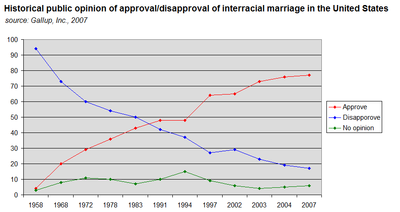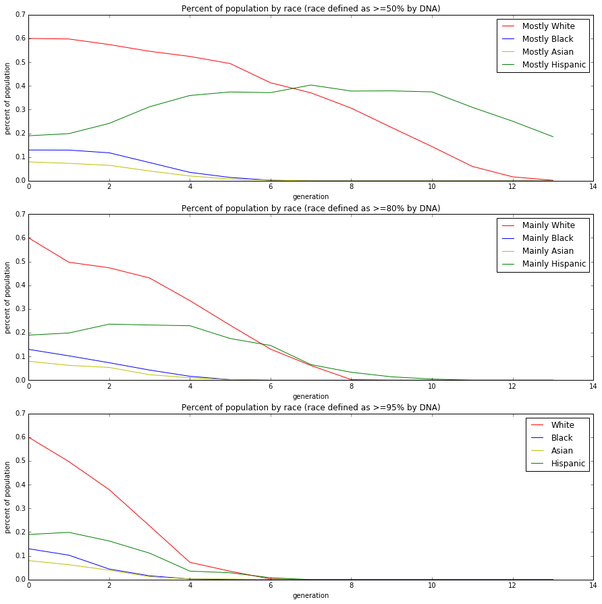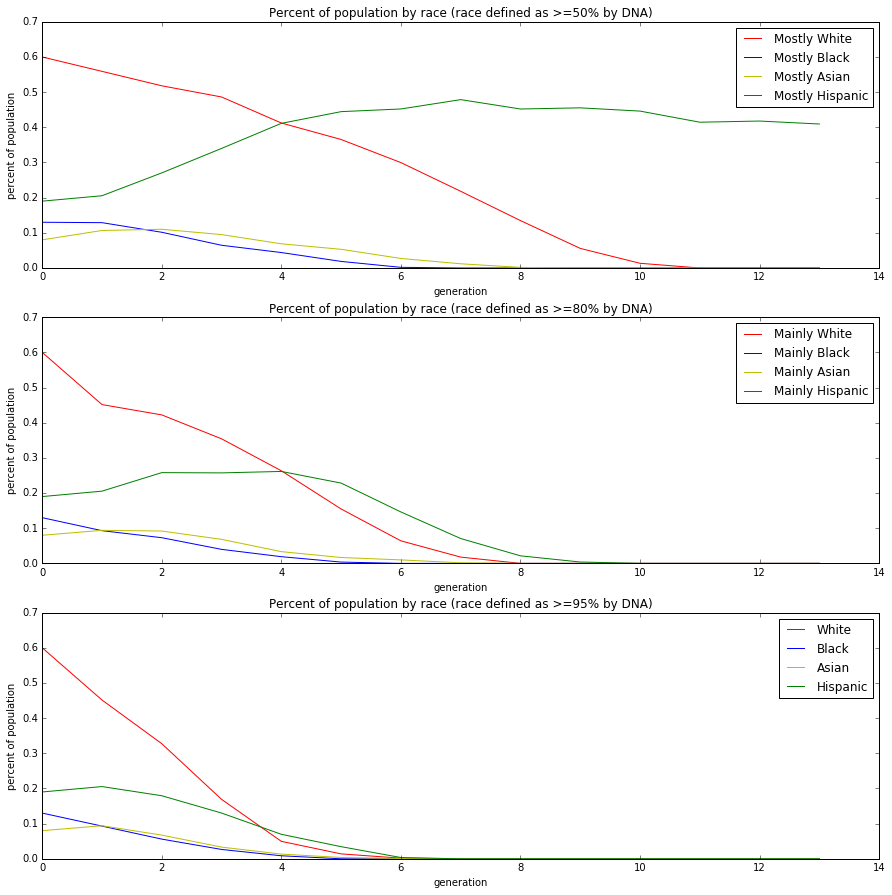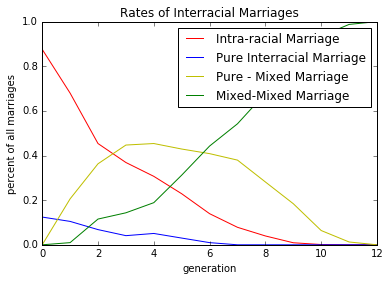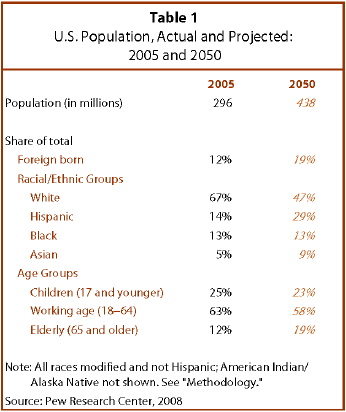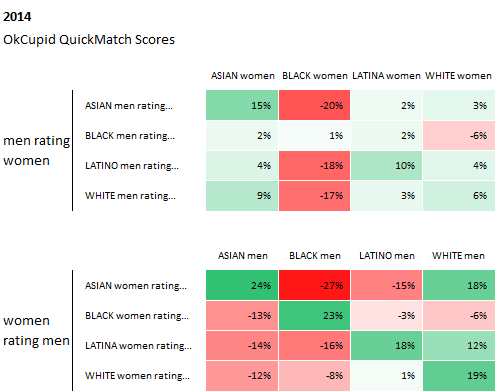Interracial Marriage & White Genocide
Posted By Phineas Eleazar On In North American New Right | Comments Disabled [1]
[1]Photo courtesy Wikimedia Commons [2]
2,555 words
There continues to be a debate within the Right over whether miscegenation is a threat to white racial survival. There are few voices on the Right strongly promoting the thesis that amalgamation is a great threat, and there are no voices – as far as this writer is aware – that would argue that it is the greatest threat. Instead, there are many voices urging us to turn a blind eye to it, and to keep confidence that miscegenation is actually rare and not likely to greatly affect the white populations of diverse countries. Instead, when the subject of white demographic decline (or “white genocide”) is raised, the Right typically focuses on issues of immigration and birthrates.
I argue that these voices are incorrect. I have performed many numerical simulations to analyze the demographic evolution of the United States which suggest that, even in the absence of any immigration, miscegenation will create a population in which, after about 340 years, there will be no more people who are even “predominantly” (defined as >50%) European by descent. I will argue that there will be virtually no “pure white” (defined as >95% European by descent) people in the US in 6 generations (168 years), irrespective of immigration conditions.
I hope that this article at least begins a discussion on this topic.
Historical Examples of Racial Amalgamation
Before looking at the simulations, the reader should strongly consider the hypothesis of genocide through racial amalgamation, as it has happened across the world many times. The racialist Right’s poster child is Egypt. From Wikipedia [3]:
The study was able to measure the mitochondrial DNA of 90 individuals, and it showed that the mitochondrial [4] DNA [4] composition of Egyptian mummies has shown a high level of affinity with the DNA of the populations of the Near East. A shared drift and mixture analysis of the DNA of these ancient Egyptian mummies shows that the connection is strongest with ancient populations from the Levant [5], the Near [6] East [6] and Anatolia [7], and to a lesser extent modern populations from the Near East and the Levant. In particular the study finds “that ancient Egyptians are most closely related to Neolithic [8] and Bronze [9] Age [9] samples in the Levant, as well as to Neolithic Anatolian [7] and European populations”.
Genome-wide data could only be successfully extracted from three of these individuals. Of these three, the Y-chromosome haplogroups of two individuals could be assigned to the Middle-Eastern haplogroup J, and one to haplogroup E1b1b1 common in North Africa. The absolute estimates of sub-Saharan African ancestry in these three individuals ranged from 6 to 15%, which is significantly lower than the level of sub-Saharan African ancestry in the modern Egyptians from Abusir, who “range from 14 to 21%.”(When using East African admixed population as reference) The study’s authors cautioned that the mummies may be unrepresentative of the Ancient Egyptian population as a whole, since they were recovered from the northern part of Egypt.
Overall the mummies studied were closer genetically to Near Eastern people than the modern Egyptian population, which has a greater proportion of genes coming from sub-Saharan Africa [10] after the Roman [11] period [11].
As is common knowledge to most of us by now, the current European population is actually itself a hybrid of proto-European races: the “Early Farmers from Anatolia,” the “Indo-Europeans” or “Yamnaya Culture,” and the “Indigenous Western Hunter-Gatherers.”
The Native American peoples [12] are hybrids of Proto [13]– [13]Mongoloid [13] and Ancient [14] North [14] Eurasian [14] races.
The South Asian peoples [15] are hybrids of four populations: Indo [16]– [16]European [16], Dravidian [17], Tibeto [18]– [18]Burman [18], and Austro [19]– [19]Asiatic [19].
And the story goes on and on.
Objections to the Amalgamation Hypothesis
Some mixings were “male-mediated”; there is a disproportionate share of Y-chromosome from one population relative to the share of overall DNA from that population. One common argument from deniers of the risk of miscegenation is that the mixing in the past only happened due to men forcing themselves on foreign women. The existence of this discrepancy does not automatically imply this, however; it simply suggests it.
But male-female discrepancies in interracial marriages are also happening in the US today [20]:
. . . according to the United [21] States [21] Census [21] Bureau [21], there were 354,000 White female/Black male and 196,000 Black female/White male marriages in March 2009, representing a ratio of 181:100.
Similar situations are happening with white-Asian couples, as Asian women outmarry at twice the rate of Asian men [22].
Thus, it is possible that “male-mediated” hybridization can happen without rape or force; that it is something that often naturally happens when races mix. And the hypothesis that amalgamation only happens due to rape should not be immediately granted due to Y-chromosome data.
Another common objection to the claim of white genocide through interracial marriage is that we have had decades of legal interracial marriage in the US which haven’t much changed the demographics, and that we should reasonably expect that the future will follow the past, and thus interracial marriage will continue to be a non-issue.
But the low miscegenation rates of the past were due to the shocking commonality of racist attitudes, which have been a bulwark against white genocide. As late as 1990, the general society was very much against interracial marriage. The millennial generation was the first in American history to be mostly raised by parents who did not teach them against miscegenation:
The Numerical Simulations
I have built some simple scripts that simulate semi-random demographic scenarios in the US. I set the initial population demographic to roughly what we have now (60% white, 13% black, 8% Asian/Other, 19% Hispanic), and give the data-persons created by my computer program racial preferences for mating and birthrates that correspond to what we observe in the US now. The result is an interracial marriage rate of about 15%, with random variance (new marriages in the US now are estimated to be interracial 18% of the time). The data-persons greatly prefer their own race, many times more than other races, but their ability to mate is also controlled by the likelihood of finding another person of their race to mate.
This corresponds to the real-life challenge of finding someone compatible to marry: We all have to pick from the limited number of people of the opposite sex we meet in our lives who are compatible enough to marry, and in an integrated country, the eligible members of the opposite sex could be of different races. Despite the fact that the own-race preference for marriage forces the interracial marriage rate between pure races to be only <15% throughout the simulation, full amalgamation is acheived by 12 generations, due to genetic drift through the mixed-race population.
My simulation treats the people in society as interacting with people of all races in the country. Of course, there will be enclaves in remote parts of the US (and other countries, I assume) of highly religious folk like the Amish, Hutterites, and so on who will not interact with people outside of their communities.
I bucket reproduction into generations. This is simpler and less computationally expensive than designing a population with an age breakdown that reproduces at certain rates on a year-by-year basis. I do not see how this would greatly change results.
I should mention that I treat mates as monogamous; I do not take into account people who mate with multiple people. This is important, as not all cultures in America maintain strict monogamous norms, and a great many children are born out of wedlock.
I realize black and Hispanic people are already mixed, but I am working with the racial groups we have with our sources of data (census, vital statistics, etc.) to make a simulation that best mirrors reality. You can shift the results over a bit if you’d like.
Thus, I have run simulations that involve continuous immigration into the US and others that involve a halt to immigration. The immigration rate is based on the rates we have now:
I do take into account that much Hispanic immigration from South America is white, and I treat immigration from Canada as being white immigration. In reality, there are likely many Asian Canadian immigrants. I also do not take into account black immigration from the Caribbean. As you will see, these little oversights are not going to affect the results greatly; the results of a no-immigration scenario are rather similar to an immigration scenario.
The future of African immigration is unclear; there could be much higher rates in the future, given the fact that the African population is growing so quickly. I can design more simulations to test these scenarios.
First, see the results of a no-immigration scenario. This is the future of America if immigration is stopped for good:
In six generations (168 years), there will be no people who are more than 95% “pure” black, white, Hispanic, or Asian. In eight generations (224 years), there will be no more whites who are more than 80% white, and in about 12 generations (336 years), there will be virtually no people who have majority European ancestry.
The Hispanic population holds on well due to their high birthrates.
The below is a scenario that includes immigration, with immigration rates that decrease every generation to 80% of the previous rates. The point of lowering immigration rates through time is to take into account that the world is improving economically, and therefore should be sending fewer immigrants over long timescales:
With immigration, you can see that the US population becomes a predominantly Hispanic population. The black population actually crashes worst, which seems incorrect to me. I will comment later on black reproduction.
The Asian population holds out better than the white. This is due to slightly higher Total Fertility rates (it is difficult to measure this correctly because of the age breakdown of Asian-Americans; different sources say different things) and high rates of Asian immigration, which replenishes the rapidly mixing existing population. Asians will still be toast within eight generations.
The white population still crashes within six to eight generations. This is only a bit faster than the no-immigration scenario. In conclusion, immigration restriction is not going to greatly improve the prospects of white survival in the US.
The Wisdom of the One-Drop Rule
It was mentioned before that race-mixing does not proceed predominately by interracial marriages between people of pure races (e.g., a pure European marrying a pure Asian). The below plot shows the forms of marriages over time:
In my simulation, the most important vector for amalgamation is actually the mixed-race people. I do not treat the data-persons as being equally opposed to marriage to a mixed-race person as they are to a pure-race person of another race. This is due to the fact that I treat mating preferences as being aesthetic and not racist in nature; I assume a generally liberal, anti-racist society, like the one we have now and are supposed to have in the future.
The reason I make this assumption is to test the thesis that race-mixing is not a threat to white survival because, supposedly, “people just find members of their own race most attractive.”
In this case, a pure-race person would be attracted to a biracial person who is midway between that of his or her two parent races. I do think that this is true in real life, in that a mulatto is, on average, far more palatable to marrying a white person than a dark-skinned, pure-black person. Their increased palatability is due to both cultural and physical factors. I feel that the same is true for white-Hispanic hybrids, but I somewhat doubt it for happas. Of course, there is no data for this, and I can test other assumptions, if desired.
But this finding should cause the reader to reconsider the one-drop rule. The reality that populations can merge, quite completely, without more than a small minority of them ever mating interracially is not a thesis that is often explored or tested. Given that it is true, the one-drop rule is not entirely a shameful disgust response to racial impurity, but also a legitimate and necessary strategy for racial preservation.
The African-American Reproductive Strategy
My simulations show that the African race in the US is in hot water, though this goes against the experience of those of us who live there. The reality is that the African race is growing in the US:
The reason this is possible is that African-Americans do not reproduce within the confines of marriage: About 72% of African-Americans are born out of wedlock [31].
The babies born to black mothers out-of-wedlock typically have black fathers. This is because African-American women strongly prefer African-American men for sex and dating, and men of other races strongly prefer non-black women:
Black women, then, drive reproduction by letting themselves be impregnated out of wedlock (often against the fathers’ wishes, as is often the butt of jokes by black comedians), which is the main source of the next generation of the black population. The illegitimate children are stereotypically “raised by the community,” which includes extended family members and the state, the latter of which provides free meals at schools.
Black men, however, do not greatly prefer black women for romance. This explains the fact that black men pursue marriage outside of their race, and marry outside their race twice as often as black women.
Whether black women are conscious of this or not, they need to become impregnated out of wedlock to reproduce their race. If the black race were to dogmatically insist on reproducing solely inside marriages, as do whites, their amalgamation would follow their interracial marriage rates and would proceed much faster:
The black way of reproduction is not accurately represented by my simulation. My simulation assumes that all people “pair up” and reproduce with their partner. In such a schema, the black intermarriage rates would be devastating. But they are not, because African-Americans do not marry nearly as often as other races [34].
When Africans do marry, they often choose members of other races. But their reproduction is not linked to their romantic activities. This allows them to “have their cake and eat it too”; they achieve both racial preservation and interracial love (or sexual conquest, if you prefer to frame it negatively). The downside is that African-American women bear a great burden in order to perpetuate this reproductive strategy.
Conclusion
The simulations presented here are not those of an expert or a scientist. A more scientific presentation of the results would, of course, present variations of the simulation, a detailed list of assumptions, and so on. To spare you the boring details, the variations of the simulation are not large, as I have programmed it to not have wild amounts of randomness built in.
Our best demographic estimates should come from the professionals. But even the professionals know that they must allow for huge error margins. And even the professional projections, regardless of whether they were from as late as 2010, might not have predicted the massive increase in interracial marriage rates we have been seeing recently [35].
We cannot know the exact extent to which interracial marriage is a threat to the white race. It is quite possible that the rate will go down, or that biracial people will not marry whites (i.e., whites impose a one-drop rule independently). But we can make an educated guess, based on the rate of mixing that exists now and the history of racial amalgamation in the past, that race-mixing is a great obstacle to the biological survival of the white race in diverse, liberal countries.
